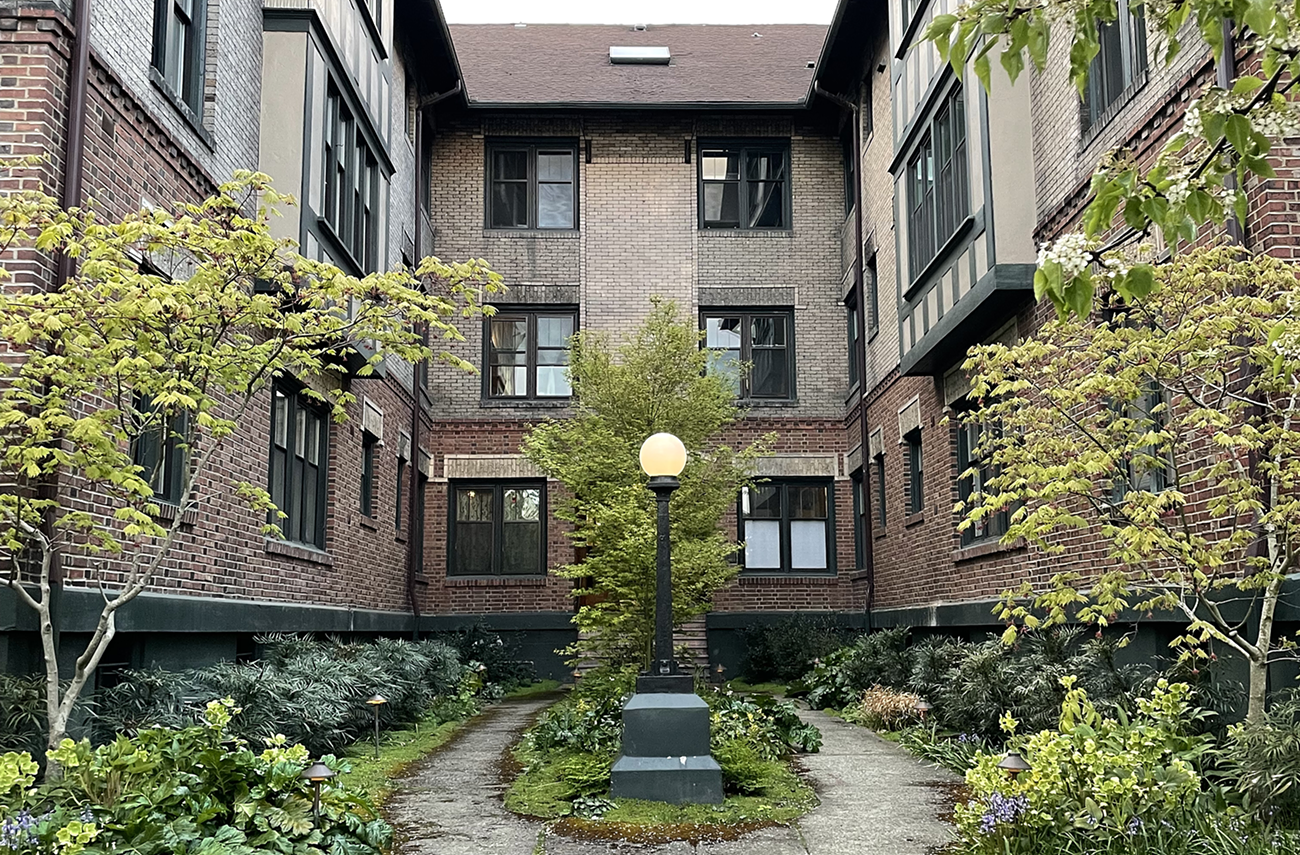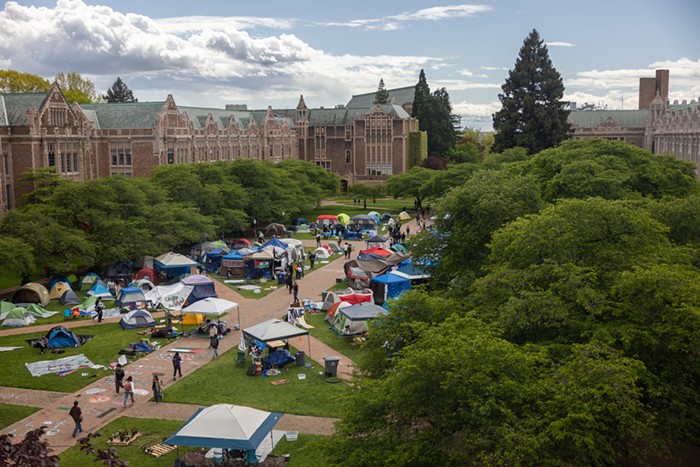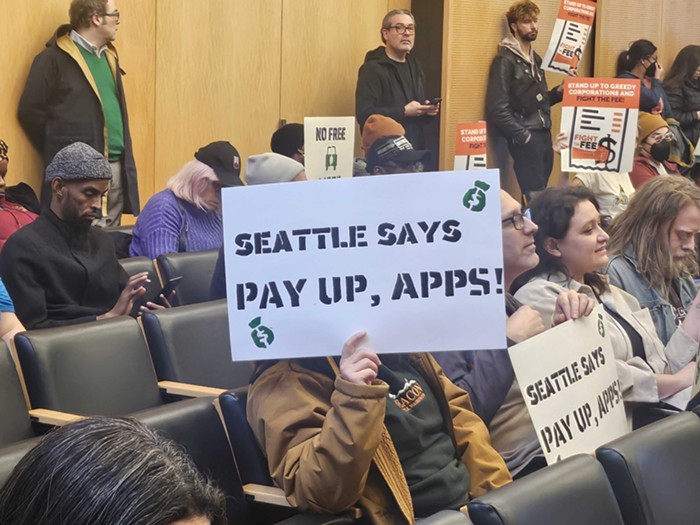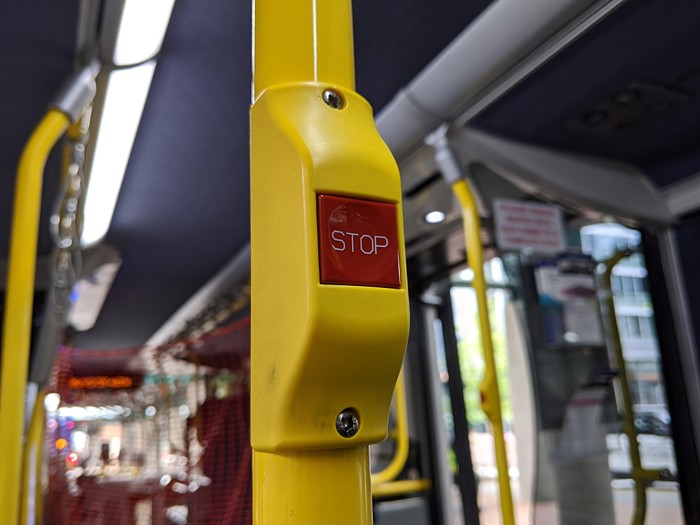News
Dec 2, 2022 at 9:30 am
You Don't Like Exorbitant Rents, Homelessness, or Sluggish Transit, Do You?
Legalize it.
COURTESY OF TECH 4 HOUSING
Comments
Please wait...
Comments are closed.
Commenting on this item is available only to members of the site. You can sign in here or create an account here.




















Eliminating SFH zoning will only result in greater housing density if the same NIMBYs who oppose the change decide to tear down their homes and replace them with multi-unit housing. And because there is little incentive to build low-income housing, most new multi-unit housing will be the same luxury townhomes we've seen popping up all over the city for the past few decades.
Proponents of eliminating SFH zoning seem to believe it's like waving a magic wand. It's not. Even if SFH zoning was eliminated today, it would take decades to see any meaningful change in housing density. Relying on the market to fix homelessness is a dumb idea.
Readers of the Stranger are generally college educated, upwardly mobile, American born. Want to be anti-racist? Pass the microphone to those actually being pushed out of the city. YIMBYs like having an abundance of upper-mid echelon apartments to them to keep their own housing costs low, but more supply here does NOT trickle down to everyone else.
Also, with great upzones comes great tax increases. Properties will be assed on highest and best use values. Think that renters won’t bear the burden of those increases? Think again.
@1 The only reason the townhouses are "luxury" is because there are very few of them. These are not expensive to construct. The amount of labor and material to build them is not that high. But because demand is high, the prices are high.
Consider an analogy. Imagine that cell phones construction was limited. You could only build 10,000 a year (as opposed to the billion or so built every year). Obviously the cost of new cell phones would be very high. The cost of old cell phones would be very high. People would make the same failed arguments made here (e. g. "what difference does it make if we have more cell phones, they will still be high end phones -- the middle class will never be able to afford that").
Or consider a local example. This happens all of the time in my neighborhood (Lake City/Northgate). This is not a high income neighborhood. But it is full of very large lots with former farm houses. These lots are typically subdivided into smaller lots. Typical single family lot sizes are 7,200 square feet. You can have a lot bigger than that, but no smaller. So a lot of 25,000 (containing one house) is replaced by three houses on three lots. Since the lots are huge, and housing construction is not fundamentally very expensive (due to modern "assembly line" construction practices) the developers put up huge houses. Three big houses on three big lots replace the one house. Often these houses go for about a million dollars -- again, in a middle class neighborhood. Thus the developer would gross around 3 million.
Now consider what would happen with town houses. That same lost could handle 25 townhouses. If the townhouses cost 200K, the developer would gross 5 million. Or they leave some space for a courtyard, and gross 4 million. It might cost a bit more to build, but not that much more.
But of course, it would be stupid in today's market to sell those for 200K. You can get way more. But as more and more are built, the price moves towards that number.
None of this means that we don't need public housing. But public housing dollars go farther if market rate housing is cheaper. We can't possibly fix the housing problem with just public housing. Where would it go, if we aren't allowed to build it? On the other hand, there are many cities that have been able to build their way out of the problem (while also building public housing): https://www.sightline.org/2017/09/21/yes-you-can-build-your-way-to-affordable-housing/
@3 "it would be stupid in today's market to sell those for 200K. You can get way more."
We are both making the same point. Changing zoning laws is a market-based solution to the housing crisis. It only works if private landowners and developers decide to build affordable multi-unit housing, or, alternatively, new construction exceeds demand.
Obviously we should do a ballot measure calling the entire City of Seattle an Historical District that defines it's character based on the time we had streetcars on all the arterials, everyone biked, and all lots were allowed to build up to 65 feet MFH with ground floor storefronts included.
There, problem solved.
@1 "Even if SFH zoning was eliminated today, it would take decades to see any meaningful change in housing density."
Quite possibly true. And all the more reason to get on with it now.
We've been a market fetishist deregulatory regime nationally for three decades. And this where it has gotten us.
You will not "build" your way into cheaper housing in an inflationary and speculative market place by relying of the profit motives of developers. The mighty market will never, ever, fix a housing scarcity or cost inflation problem with out a massive economic contraction. It never has. It never will.
It's sorta like trying to fight the Drug War by seizing drugs, thus driving up the prices making more profit for the cartels.
Every single permutation of incentivizing developers has been tried over and over everywhere and yet housing costs are up in pretty much every single major city and many second tier cities in the western wealthy OEDC world.
The only way is to shatter the market entirely by building public or subsided housing and/or interfering in the market with regulations. And even that is only at best holding the line and forestalling the inevitable.
@7 bingo. “Social housing” is our best option, to put affordable units on the market and apply downward pressure on prices generally.
The price fixing scheme reveal by landlords (Pro Pública published a couple months ago) really underscored the fact that the market can be manipulated; it’s foolish to think it will save us.
@1 In other words, rezoning is only a necessary element in reducing housing costs, not a sufficient one.
Duly noted.
@10 There are 3BR 2BA townhomes, a few 3BR apartments, as well as 2BR 1 BA single family houses in my neighborhood. (While single family houses are probably the go-to if you want 4 and 5 bedrooms, in Seattle at this time single family houses that size are only accessible to the affluent anyway.)
Once again, the Stranger pushes the least-effective housing solution because of ideology and grudge, using blatantly dishonest arguments. This time, it opens with the innuendo that anyone who doesn’t want to burn down SFH neighborhoods is a racist, and closes by justifying policy based on flat-out fantasies about the Parisian vacations of those richy-rich residents of (wait for it) Laurelhurst.
In between, we have the usual demands to rezone Seattle to increase population density in SFH neighborhoods, with no hint as to how everyone will get into and out of those denser neighborhoods. There is currently no plan for any grade-separated transit into those neighborhoods - zero, zilch, zip, nada. (Consider I voted for Sound Transit in 1996, and stepped aboard the first train in 2009. During that time, it had shrunk from a Puget Sound system to a Seattle system to a South Seattle system, the price increasing with each loss of range.) So there will be no transit to serve those up-zoned neighborhoods, just more ever-increasing ground traffic.
If writers at the Stranger could afford to live in the North End, they would be the NIMBYest NIMBYs who ever NIMBYed.
God what we have for idiots in this city.... We need planning.
We can have both single family homes and density of housing, IF we use our heads. Along arterials, one builds high more dense multi-family units. Doh! Then as you go back from these higher density areas you retain some semblance and order of single family homes.... and advise them that the 10 year plan will allow for progressively higher density as one steps back from the arterials... as time goes on. Now everybody knows what the game plan is and the rules.
Instead we have a Seattle procress of messed up meetings where everybody has an opinion but NO PLAN. One week its SDOT on their bike trails, next week its a Seattle NIMBY fest, followed by the Green Brigade and The Save the Whales crowd... but again no comprehensive, intelligent plans....
I think both the directors of SDOT & Seattle Dept of Communism and Land Use (building dept of Seattle) should be put in stocks at Westlake Mall for a weekend and peppered with rotten tomatoes.
@13 A kid can have a perfectly good childhood without their own trampoline. Most anything else you might do in a private yard can also happen just as well in a public park, if not better. You might have a little swingset in your back yard; the park has a big playground. You might have a grill and seating for six in your back yard; the park has a giant shelter with dozens of tables. You might have a basketball hoop in your back yard; a park has a full court. Meanwhile @11's comment about detached houses being only attainable for the affluent is spot on. Unless you have a realistic plan for changing that, you'd better be looking at solutions for how families without yards (who do exist! and will continue increasing in number!) can gain sufficient recreation, instead of claiming such a thing is impossible.
@14 Forcing everyone who can't afford a detached house to live along noisy, polluted arterial streets is the opposite of a good plan. The city is looking at alternatives to that: mixing smaller-scale apartment buildings onto the same blocks as detached single-family houses. That's a good thing. Our cities don't need to be "ordered" in the sense that everyone should be segregated by income. Zoning for single-family houses in one area and apartments in another does just that.
@15: “Forcing everyone who can't afford a detached house to live along noisy, polluted arterial streets is the opposite of a good plan. The city is looking at alternatives to that: mixing smaller-scale apartment buildings onto the same blocks as detached single-family houses.”
That’s what @14 described: the gradual introduction of higher density into current SFH neighborhoods. Simply up-zoning all SFH, and letting density grow at random, risks turning SFH backstreets into “noisy, polluted arterial streets” with neither plan nor warning.
@16: That caught my eye as well, as my rooming-house rent in the early ‘90s was more than that, and my mid-90s apartment rent was twice that. I suppose it’s barely within the realm of possibility he had a tiny room in a run-down house at the edge of the city, but that would still be more of a 1991 thing than a 1999 thing. By the late ‘90s, the dot-com boom was in full swing, and whining about rising rents was the norm, as your url showed.
@13 I myself grew up in triple deckers. They all had yards and gardens. (No trampolines, I am sure my mom would have considered them too dangerous). Stacked flats and smallplexes and townhomes can have outdoor space too, and more affordably than single family large lot houses.
The photo at the top of the piece completely misrepresents the result of upzoning. Look around! Instead of pleasant courtyard buildings, all developers are building is townhouses or rowhouses with no backyards whatsoever. Here in low-income Lake City, you can put 8 rowhouses on a 6,000 s.f. lot and sell each for $700,000. That's not affordable to a working-class couple, They fail to be affordable at all to anyone making less than $32/hr.
All the rest of the Missing Middle Housing (duplexes, triplexes, quads, stacked flats, courtyard buildings) is still missing, because they're not as profitable. This elimination of zoning is a deregulation scheme dreamed up by the Market Urbanists and Builders Assn. It's not progressive. Building far from frequent bus transit forces families to use more car trips. It's anti-environmental. Don't fall for it.
Instead, allow taller towers in Northgate and other hub Urban Villages. Require rowhouses to have a backyard, as East Coast rowhouses do, for trees, kids, dogs, and gardens. Don't allow developers to subdivide lots, build lotline-to-lotline and sell ADUs separately, when ADUs were supposed to provide affordable rental units.
Developers' greed should not be our guiding principle. We need a lot more Social housing. Vote for I-135 in February.
The Seattle Comprehensive Plan is required under the State's Growth Management Act. The first one was in 1995, the second in 2015 and the current plan is for 2035. There is no 10-year plan. The update was delayed by Covid. It will be finalized in 2024. The Legislature added a housing component to the plan. It must be broken out by housing unit type and incomes. This will be hard to do if the City lets developers build whatever they want wherever they want. Matching density to bus and rail transit makes more sense. Eliminating diesel trucks will ease highway pollution.
I'm surprised so few people here are mentioning the climate crisis and our shared need for natural habitat. I'm all for high density and low income housing, but why clearcut everything to cram in more unaffordable units. Developers are using the high density notion to build huge homes on single lots with no yard. That benefits no one, including the fools who buy those homes. People living in apartments or condos can benefit from preserving trees and natural habitat too. Developers need to be required to design homes, both multi and single units, around standing groves of native trees, and we need to stop separating ourselves from the environment. In the long run, we will pay for it all, when the concrete jungles replacing our groves of northwest trees and undergrowth make our lives unlivable with the extreme heat waves, unbreathable air, and all the yet to be seen results of our willful neglect of preserving our natural habitat as much as possible. Let's not cut off our nose to spite our face.